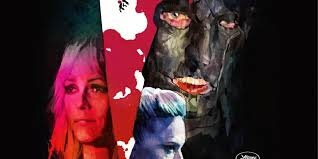A simple plot description would skim over some very colorful details, like the pear-shaped fluffer nicknamed bouche d’or (“golden mouth” in English), the anarchistic girl gang of transgender sex workers, the bloody lesbian burlesque routine, and the bird expert with soulful eyes and a scaly chicken hand. But these are the basics: A troupe of gay porn actors is being stalked and killed one by one by a serial killer who covers his face with a black leather hood—a “leather-daddy Leatherface,” as our own A.A. Dowd put it in his review from Cannes—and stabs his victims to death with a blade hidden inside of a thick black dildo. The cops, of course, are completely ineffective, leaving director Anne Parèze (Vanessa Paradis) to lead the investigation into her actors’ deaths. She does so in between bouts of heavy drinking and obsessively trying to win back her ex-girlfriend, Loïs (Kate Moran), who still works with the troupe as an editor.
Brittle, manipulative, and insensitive to her friends’ fears until one of them is practically murdered in front of her, Anne breaks the mold of the naïve young sexpot who’s usually the heroine in a giallo film. Paradis plays this objectively rotten person with a great deal of sympathy, as a tragic, exhausted alcoholic tortured by unrequited love and her own jealous tendencies. The matriarch of this oddball chosen family, she’s really the only fleshed-out character in the film, her subconscious splayed on screen in the adult films whose integrity she so passionately defends.
These movies-within-the-movie further blur the boundaries between fiction and reality, in so much as anything in this film can be called “reality.” Acutely aware of its camp value, Knife + Heart also uses its faux pornos to insert moments of humor into the story: Anne incorporates the real-life murders of Guy (Jonathan Genet) and Thierry (Félix Maritaud) into her new movie, Homocidal, starring Anne’s best friend, Archibald (Nicolas Maury), in drag solving crimes and getting foot jobs from lusty, mustachioed cops. (It is a porno, after all.) But while the film’s violence is relatively graphic, Gonzalez leaves much of the sexual content to the imagination, with only a fleeting shot of what appears to be an un-simulated blowjob violating his strategy of impishly framing all manner of debauched acts from the waist up.
You may be thinking, “Well, that’s not very Gallic, is it?” No, the ineffable Frenchness of Knife + Heart comes from the lush, disco-influenced original score from French electronic outfit M83 (led by Gonzalez’s brother, Anthony), and from a studied fascination with queering classical aesthetics, most evident in a picnic scene posing Anne’s merry band of proud perverts in tableaux reminiscent of the Renaissance masters. As with its giallo influence, this continental sophistication has its drawbacks—namely, a sense of navel-gazing detachment that ironically renders the film’s most lurid scenes a little limp. Gonzalez seems to want us to admire the sex and violence rather than be aroused or frightened by them, a distinction that makes this perverse little thriller more of an intellectual pleasure than a prurient one. Still, maybe don’t watch it with your mom.

